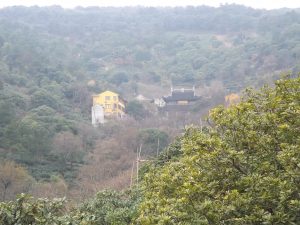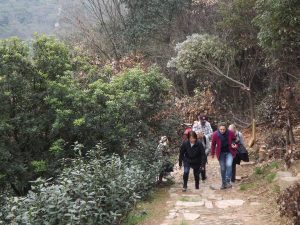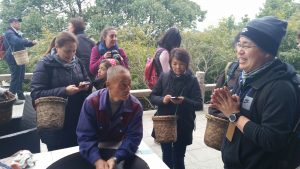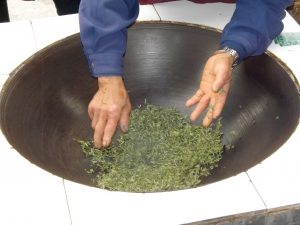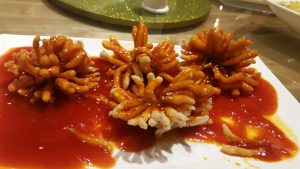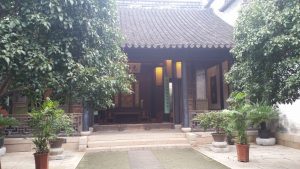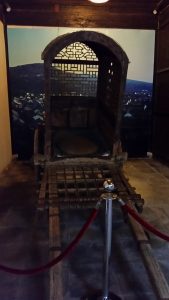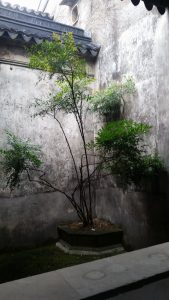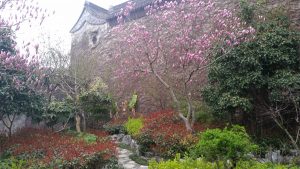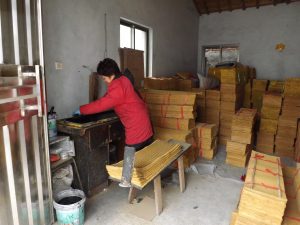I went to Dongshan Island again today with another tour group. My friend Amy owns a travel agency and I help her from time to time. Most of the group were Westerners and some had travelled as far as Shanghai. The weather was overcast and the rain threatened but luckily it stayed dry. In fact the cloud cover made it a perfect day for walking up the steep hill on the island. This week I have been walking up to the top floor of my apartment block and so this wee stroll up the hill at Dongshan was relatively easy and I passed many people on the trail as I made my way to the top and that included many young ones. In fact there was one young girl that was sitting at the top ready to retrieve her breakfast.
The climb is quite steep and you zig zag up through 24 stages until you reach the top. The reason for coming today was so that we could get the first taste of the Biluochun Green tea which is grown here. It is grown alongside loquat fruit trees and it is this combination that helps to give the Biluochn its distinctive flavour. You do get the opportunity to pick the tea but it does take quite along time to pick enough for a cup and so thankfully when we reach the top there is a lovely cup of tea waiting for us.
But before we can get to taste it you have to watch the process of roasting the tea and this is done by hand. This is how it has been done for centuries although now you can get a little help from a gas powered wok.
The tea must be dried properly before use and when it is the leaves are very curly, but they retake their previous form once water is added back into the mix and of course as all tea jennies know, you don’t use boiling water to make tea but you have it at 80c to make the perfect cup of tea.
This is the wonderful tea house at the top of the mountain.
Lunch is served using only seasonal and local foods. There are fish for the lake and fruits from the island.
This is eel served with ginger……
One of my favourite dishes, sweet and sour flower fish. The fish is made to look like a Chrysanthemum. Not sure how long it takes to prepare but I like it because there are no bones and the flavour is great. In fact it’s a good combination with the eel.
This is sticky rice with red bean inside, not one of my favourite desserts but it is very popular in China to have these kind of sweets.
After lunch we walk to the village on the opposite side of the island and we eventually come to Lijiang village and we are invited into one of the best preserved Ming Dynasty officials houses. This is the courtyard you come into after you have parked your Sedan chair which of course you can see in the pictures below. There are a his and hers, actually that should be hers and his.
After we tour the house we head out through the garden and back into the busy narrow streets of the village as we head for the bus.
This woman is printing by hand paper money that’s used when you visit your dead relatives. It is burned at the grave to make sure they have enough money to look after themselves. Maybe buy some takeaway or a new mobile or something.

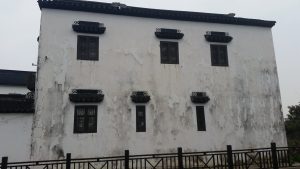 Suzhou buildings are mostly black and white and I think that even when they are old looking and a bit worse for wear they still have great character. The courtyard above leads into another large home and has been restored and it does look magnificent. Although much of the Chinese culture and architecture can be elaborate I also think that they bring a certain elegance with their simplicity of the contrast with black and white.
Suzhou buildings are mostly black and white and I think that even when they are old looking and a bit worse for wear they still have great character. The courtyard above leads into another large home and has been restored and it does look magnificent. Although much of the Chinese culture and architecture can be elaborate I also think that they bring a certain elegance with their simplicity of the contrast with black and white.

